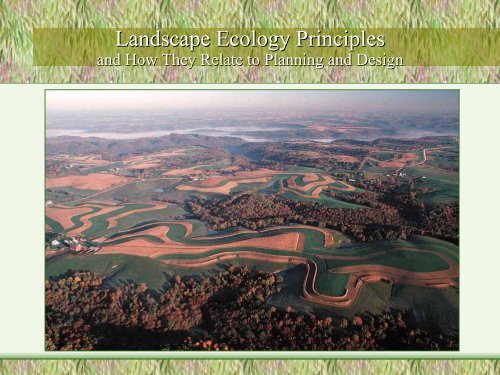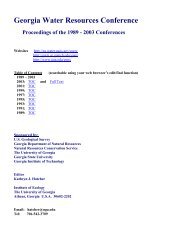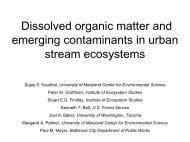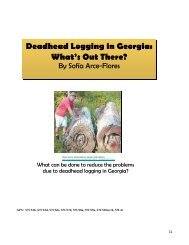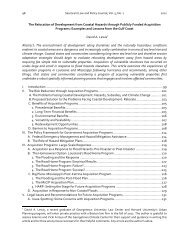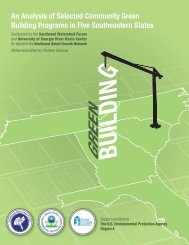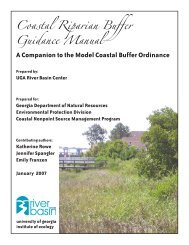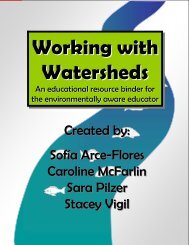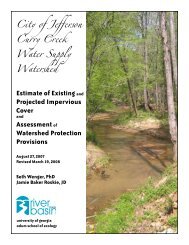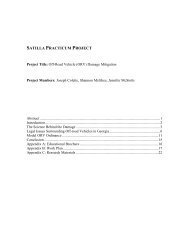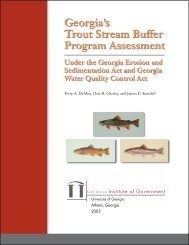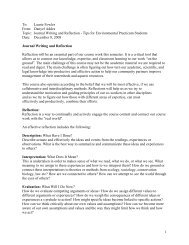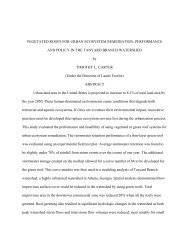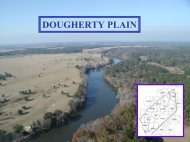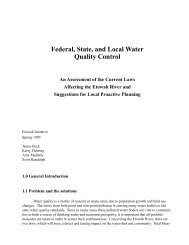Landscape Ecology Principles - River Basin Center at the University ...
Landscape Ecology Principles - River Basin Center at the University ...
Landscape Ecology Principles - River Basin Center at the University ...
Create successful ePaper yourself
Turn your PDF publications into a flip-book with our unique Google optimized e-Paper software.
<strong>Landscape</strong> <strong>Ecology</strong> <strong>Principles</strong><br />
and How They Rel<strong>at</strong>e to Planning and Design
Wh<strong>at</strong> is <strong>Landscape</strong> <strong>Ecology</strong>?<br />
ECOLOGY<br />
The study of <strong>the</strong> interactions<br />
among organisms and <strong>the</strong>ir<br />
environment<br />
LANDSCAPE<br />
An expanse of land over which<br />
particular local ecosystems and<br />
land-uses recur<br />
LANDSCAPE ECOLOGY<br />
The ecology of landscapes
Characteristics of <strong>Landscape</strong>s (Living Systems)<br />
STRUCTURE<br />
Sp<strong>at</strong>ial p<strong>at</strong>tern of landscape<br />
elements<br />
Credit: Plan by Preston & Associ<strong>at</strong>es
Characteristics of <strong>Landscape</strong>s (Living Systems)<br />
STRUCTURE<br />
Sp<strong>at</strong>ial p<strong>at</strong>tern of landscape<br />
elements<br />
FUNCTION<br />
movement and flow of resources<br />
through <strong>the</strong> structure
Characteristics of <strong>Landscape</strong>s (Living Systems)<br />
STRUCTURE<br />
Sp<strong>at</strong>ial p<strong>at</strong>tern of landscape<br />
elements<br />
FUNCTION<br />
movement and flow of resources<br />
through <strong>the</strong> structure<br />
CHANGE<br />
Disturbance or evolution of<br />
structure and function over time
Wh<strong>at</strong> <strong>Landscape</strong> <strong>Ecology</strong> offers<br />
1. Examines how <strong>the</strong> sp<strong>at</strong>ial<br />
arrangement of land affects<br />
functions for humans, o<strong>the</strong>r life<br />
forms and abiotic processes.<br />
2. Allows us to infer something<br />
about n<strong>at</strong>ural processes and<br />
biodiversity protection, even in<br />
<strong>the</strong> absence of d<strong>at</strong>a about a<br />
specific site.<br />
3. Concepts of <strong>Landscape</strong> <strong>Ecology</strong><br />
apply to almost any site, <strong>at</strong> any<br />
scale.<br />
Perlman & Milder, 2005
Concepts of <strong>Landscape</strong> Scale<br />
GRAIN<br />
Sp<strong>at</strong>ial resolution of a study.<br />
Smaller grain = ability to<br />
distinguish smaller objects.
Concepts of <strong>Landscape</strong> Scale<br />
GRAIN<br />
Sp<strong>at</strong>ial resolution of a study.<br />
Smaller grain = ability to<br />
distinguish smaller objects.<br />
EXTENT<br />
size of <strong>the</strong> area being studied
Concepts of <strong>Landscape</strong> Scale<br />
Perlman & Milder, 2005<br />
“think globally, plan regionally, and <strong>the</strong>n act locally.” -- R.T.T. Forman
<strong>Landscape</strong> Structure<br />
PATCHES + CORRIDORS + MATRIX =<br />
MOSAIC
<strong>Landscape</strong> Structure<br />
PATCHES CORRIDORS MATRIX MOSAIC<br />
Origins of P<strong>at</strong>ches:<br />
• Remnant<br />
• Introduced<br />
• Disturbance<br />
• Environmental Resources
<strong>Landscape</strong> Structure<br />
PATCHES CORRIDORS MATRIX MOSAIC<br />
Origins of P<strong>at</strong>ches:<br />
• Remnant<br />
• Introduced<br />
• Disturbance<br />
• Environmental Resources
<strong>Landscape</strong> Structure<br />
PATCHES CORRIDORS MATRIX MOSAIC<br />
Origins of P<strong>at</strong>ches:<br />
• Remnant<br />
• Introduced<br />
• Disturbance<br />
• Environmental Resources
<strong>Landscape</strong> Structure<br />
PATCHES CORRIDORS MATRIX MOSAIC<br />
Origins of P<strong>at</strong>ches:<br />
• Remnant<br />
• Introduced<br />
• Disturbance<br />
• Environmental Resources<br />
Analyzed in terms of:<br />
•Size<br />
• Quantity<br />
• Loc<strong>at</strong>ion<br />
• Shape<br />
• Edge structure
<strong>Landscape</strong> Structure<br />
PATCHES CORRIDORS MATRIX MOSAIC<br />
Origins of P<strong>at</strong>ches:<br />
• Remnant<br />
• Introduced<br />
• Disturbance<br />
• Environmental Resources<br />
Analyzed in terms of:<br />
•Size<br />
• Quantity<br />
• Loc<strong>at</strong>ion<br />
• Shape<br />
• Edge structure
<strong>Landscape</strong> Structure<br />
PATCHES CORRIDORS MATRIX MOSAIC<br />
Origins of P<strong>at</strong>ches:<br />
• Remnant<br />
• Introduced<br />
• Disturbance<br />
• Environmental Resources<br />
Analyzed in terms of:<br />
•Size<br />
• Quantity<br />
• Loc<strong>at</strong>ion<br />
• Shape<br />
• Edge structure
<strong>Landscape</strong> Structure<br />
PATCHES<br />
CORRIDORS MATRIX MOSAIC<br />
Five major functions:<br />
• Habit<strong>at</strong><br />
• Conduit<br />
• Filter / Barrier<br />
• Source<br />
•Sink<br />
Credit: Sketch from Yaro, 1988
<strong>Landscape</strong> Structure<br />
PATCHES<br />
CORRIDORS MATRIX MOSAIC<br />
Five major functions:<br />
• Habit<strong>at</strong><br />
• Conduit<br />
• Filter / Barrier<br />
• Source<br />
•Sink
<strong>Landscape</strong> Structure<br />
PATCHES<br />
CORRIDORS MATRIX MOSAIC<br />
Five major functions:<br />
• Habit<strong>at</strong><br />
• Conduit<br />
• Filter / Barrier<br />
• Source<br />
•Sink<br />
Analyzed in terms of:<br />
• Width<br />
• Connectivity<br />
Credit: Sketch from Yaro, 1988
<strong>Landscape</strong> Structure<br />
PATCHES<br />
CORRIDORS MATRIX MOSAIC<br />
Five major functions:<br />
• Habit<strong>at</strong><br />
• Conduit<br />
• Filter / Barrier<br />
• Source<br />
•Sink<br />
Analyzed in terms of:<br />
• Width<br />
• Connectivity
<strong>Landscape</strong> Structure<br />
PATCHES<br />
CORRIDORS MATRIX MOSAIC<br />
Five major functions:<br />
• Habit<strong>at</strong><br />
• Conduit<br />
• Filter / Barrier<br />
• Source<br />
•Sink<br />
Analyzed in terms of:<br />
• Width<br />
• Connectivity
<strong>Landscape</strong> Structure<br />
PATCHES CORRIDORS MATRIX MOSAIC<br />
Simply,<br />
The dominant context of <strong>the</strong> landscape.<br />
Credit: Sketch from Yaro, 1988
<strong>Landscape</strong> Structure<br />
PATCHES CORRIDORS MATRIX MOSAIC<br />
Simply,<br />
The dominant context of <strong>the</strong> landscape.<br />
Wh<strong>at</strong> is identified as <strong>the</strong> m<strong>at</strong>rix<br />
depends on <strong>the</strong> extent of <strong>the</strong> landscape<br />
th<strong>at</strong> is being analyzed.<br />
Credit: Sketch from Yaro, 1988
<strong>Landscape</strong> Structure<br />
PATCHES + CORRIDORS + MATRIX =<br />
MOSAIC<br />
N<strong>at</strong>ural Mosaic based on:<br />
• Soil types<br />
• Moisture<br />
• Topography<br />
• Disturbances<br />
Key Sp<strong>at</strong>ial Processes<br />
resulting from human<br />
activity:<br />
• Dissection<br />
• Perfor<strong>at</strong>ion<br />
• Fragment<strong>at</strong>ion<br />
• Shrinkage<br />
• Attrition Credit: Sketch from Yaro, 1988<br />
Perlman & Milder, 2005
<strong>Landscape</strong> Structure<br />
PATCHES + CORRIDORS + MATRIX =<br />
MOSAIC<br />
Key Sp<strong>at</strong>ial Processes:<br />
• Fragment<strong>at</strong>ion<br />
• Dissection<br />
• Perfor<strong>at</strong>ion<br />
• Shrinkage<br />
• Attrition<br />
Analyzed in terms of:<br />
• Scale<br />
• P<strong>at</strong>tern / Connectivity<br />
The gre<strong>at</strong>est impact to sensitive n<strong>at</strong>ive species<br />
occurs early in <strong>the</strong> land transform<strong>at</strong>ion process<br />
Dispersed development is almost always more<br />
detrimental to n<strong>at</strong>ural communities than a<br />
comparable amount of concentr<strong>at</strong>ed development.<br />
Perlman & Milder, 2005
<strong>Landscape</strong> Function<br />
Flow of Resources:<br />
• Soil / Nutrients<br />
• W<strong>at</strong>er<br />
• Species<br />
• Energy
<strong>Landscape</strong> Function<br />
Flow of Species:<br />
• provide Home Range used<br />
for day-to-day feeding and<br />
shelter<br />
• allow Migr<strong>at</strong>ion – seasonal<br />
movement from one habit<strong>at</strong> to<br />
ano<strong>the</strong>r<br />
• allow Dispersal – movement<br />
beyond typical range to allow<br />
establishment of new<br />
popul<strong>at</strong>ions<br />
Perlman & Milder, 2005
<strong>Landscape</strong> Change<br />
N<strong>at</strong>ural Disturbance:<br />
•Fire<br />
• Flood<br />
•Wind<br />
• Drought<br />
Human Activities<br />
• Construction<br />
• Management techniques<br />
• Introduction of exotic sp.<br />
Succession
<strong>Landscape</strong> Change<br />
.<br />
Succession
Applying <strong>Landscape</strong> <strong>Ecology</strong> <strong>Principles</strong><br />
Different Scales:<br />
•Region<br />
• <strong>Landscape</strong><br />
• Site
Applying <strong>Landscape</strong> <strong>Ecology</strong> <strong>Principles</strong><br />
Different Scales:<br />
•Region<br />
• <strong>Landscape</strong><br />
• Site<br />
Planning<br />
• Land Use Plans<br />
• Greenspace Acquisition Plans<br />
• Conserv<strong>at</strong>ion Plans
Applying <strong>Landscape</strong> <strong>Ecology</strong> <strong>Principles</strong><br />
1. Large n<strong>at</strong>ural p<strong>at</strong>ches.<br />
• Protect interior species<br />
• Accommod<strong>at</strong>e n<strong>at</strong>ural disturbances<br />
2. Veget<strong>at</strong>ed riparian corridors.<br />
• Essential protection for aqu<strong>at</strong>ic sp.<br />
• Important corridors for migr<strong>at</strong>ion<br />
3. Connectivity between large p<strong>at</strong>ches.<br />
• Necessary for movement, migr<strong>at</strong>ion<br />
and dispersal.<br />
4. N<strong>at</strong>ural remnants in humandomin<strong>at</strong>ed<br />
areas.<br />
• Areas of high conserv<strong>at</strong>ion value<br />
• Areas providing essential<br />
ecosystem services<br />
• Remnants of former n<strong>at</strong>ural m<strong>at</strong>rix<br />
Wh<strong>at</strong> should be preserved?<br />
“Indispensable P<strong>at</strong>terns” for Biological Conserv<strong>at</strong>ion<br />
Perlman & Milder, 2005
Applying <strong>Landscape</strong> <strong>Ecology</strong> <strong>Principles</strong><br />
Different Scales:<br />
•Region<br />
• <strong>Landscape</strong><br />
• Site<br />
Planning<br />
• Land Use Plans<br />
• Greenspace Acquisition Plans<br />
• Conserv<strong>at</strong>ion Plans<br />
Site Design<br />
•Parks<br />
• Golf Courses<br />
• Subdivisions...
Applying <strong>Landscape</strong> <strong>Ecology</strong> <strong>Principles</strong><br />
Different Scales:<br />
•Region<br />
• <strong>Landscape</strong><br />
• Site<br />
Planning<br />
• Land Use Plans<br />
• Greenspace Acquisition Plans<br />
• Conserv<strong>at</strong>ion Plans<br />
Site Design<br />
•Parks<br />
• Golf Courses<br />
• Subdivisions...


